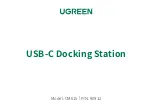
La Crosse Technology, Ltd.
Page 11
new growth on trees or bushes that causing another barrier. Radio Frequency (RF)
signal does not travel well through foliage due to the moisture content.
•
Occasionally adding a new wireless electronic device to the home will cross the signal
path for the sensor. If this occurs try moving your station a few feet or turning the
station 90 degrees for a better angle to receive the sensor signal.
•
When you have good batteries, and good location, hold the SENSOR button for three
seconds to search for your sensors. If you regain connection while the sensor is
mounted, great. If you do not regain connection, bring the sensor within 10 feet of the
station and search again.
WIND INTERMITTANT: WHY DO MY WIND AND RAIN READINGS COME AND
GO?
•
RF (radio frequency) communication may come and go occasionally. This can be
normal in some environments (e.g. moister climates).
•
If a sensor goes out, please wait 2-4 hours for it to reconnect on its own. Please be
patient – these stations can reconnect on, after many hours out.
•
RF (radio frequency) communication is not always 100% on. Certain temporary
conditions can cause it to go out for a time (e.g. 100% humidity).
If a miss happens:
•
If multi-sensor loses connection to the weather station for any reason, the weather
station will show dashes after 30 minutes.
•
The weather station will search for 5 minutes every hour to reconnect with multi-
sensor.
•
. Manually search for your sensor.
Try this:
•
Bring your multi-sensor within 10 feet of your station and make sure it is connected to
the station.
•
After 15 minutes move the multi-sensor into the next room with a wall between the
sensor and the station for 1 hour.
•
If there is no loss of signal in that hour, move the multi-sensor just outside.
•
Continue moving the multi-sensor back to its original location.
•
If you lose connection, look for sources of
WIND ACCURACY: WHY IS MY WIND SPEED INACCURATE?
•
What are you comparing your wind speed to? Your local reporting station is miles from
your location and should not be used for comparison.
•
Check the unit of measure (MPH, or KMH).
•
Check to see if your station receives the same repetitive wind speed recording from
the sensor multiple times.
•
Confirm the direction is working correctly.
•
Check that the cups turn freely.
•
Check for obstructions that prevent clear wind flow to the cups.
•
Check mounting. In most cases, the wind sensor needs to be 6 feet or more above the
highest point on the roof in order to clear nearby obstructions and read accurately. A
50-foot clearance in all directions is best.









































